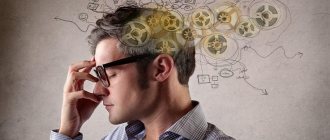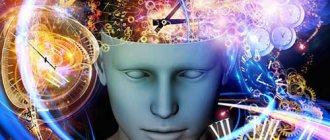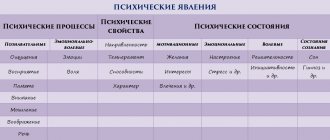CONSCIOUSNESS, one of the central general scientific and philosophical concepts, which has a wide range of meanings (“Proteus of Philosophy”, according to E. Cassirer): 1) the state of “waking”, in contrast to unconscious states - deep sleep, fainting, etc. (cf. ., for example, such expressions in everyday use as “lose consciousness” or “gain consciousness”); 2) a state of “sanity”, which presupposes the possibility of reporting about one’s experiences and actions (the moral aspect of S. is connected with this, fixed in the concepts of responsibility, conscience, etc.); 3) a set of phenomena of subjective experience, including an element of reflection, the same as self-consciousness; 4) a system of certain attitudes and ideas about the world (S. “historical”, “class”, “moral”, etc.). As a subjective experience, S. includes both sensory and semantic components (see Imagination, Perception, Thinking).
Due to the ambiguity of this concept, it is designated in modern times. languages, terms that do not always have the same meaning, some of which highlight the state of shared knowledge (Russian “consciousness”, Latin conscientia), others – personal awareness (German Bewusstsein), others – vigilant wakefulness (English awareness). Many of these terms are relatively recent. Until the 18th century The word that is closest in meaning is Russian. language there was a word “conscience”. This word has been preserved in the meaning of S. in the Serbo-Croatian language and in Russian. the adjective “conscious”, which has the semantic connotation of “conscientious”. Like Lat. conscientia, modern French conscience is used in both meanings - morals. origin, conscience, and cognitive capacity for reflection.
Definition of the concept of “consciousness” in psychology
Consciousness in psychology is a set of interconnected information reflected in a person’s memory about the surrounding world and human life, which also includes the awareness of the person himself in this world and his attitude towards society, people and the whole world as a whole.
Consciousness is formed in the process of human interaction with the environment, as well as in the process of learning and communicating with people.
The processes of the human body through which consciousness is formed can be called the following processes:
- sensation;
- perception;
- thinking;
- imagination;
- memorization.
If any of the above processes are disrupted, this can lead to various disruptions in the functioning of consciousness and its disorders. A person, unlike an animal, can be aware of himself and also engage in self-knowledge.
Thanks to the presence of his “I” in the consciousness, a person can set goals dictated not only by instincts and physiological needs (as is the case with animals), but also goals formed thanks to individual, abstract thinking based on social, scientific and everyday knowledge.
Main characteristics of consciousness
Actively. This characteristic applies to many animals, but a distinctive feature of man is the ability to psychologically reflect reality, to perceive the world around him not passively and indifferently, but according to the degree of significance. Such differentiation occurs consciously, but without human intervention in the psychological processes of the brain.
Intentionally. This property means “aspiration”, “direction”. The characteristic of consciousness is expressed in a person’s desire to realize a goal that appears as a result of conscious thinking or unconscious intention. In the literal sense, “intention” implies a person’s attraction to the implementation of a given task without direct intervention.
The presence of the main characteristics of consciousness produces the following properties:
Psychological reflection through the use of human feelings and cognitive processes (memory, thinking, sensation, imagination, perception). When one of the processes is disrupted, conscious actions are also disrupted. Self-esteem and reflection. A person is able to observe himself, control emotions, thoughts and actions. Thanks to this, human ideals and values are born. Hegel's statement reflects this characteristic well. He said that although man is an animal, he is aware of it, which means he is no longer an animal. Ability to make sound judgments. This property is clearly manifested in moral feelings and judgments, moral qualities and life values. Setting a goal. A person is able, on the basis of conscious activity, to make decisions, make plans, motivate himself, and make some adjustments.
It is noteworthy that all information received by the brain is processed and realized by a person. At first, a person takes active steps to assess the situation that has occurred, and then the processes are automated.
Functions of consciousness and properties
Consciousness performs the most important functions in human life. With the help of consciousness and the interaction of its constituent structures, a person analyzes the information received from the outside, evaluates it and processes this information to make all kinds of decisions in the process of life.
Consciousness has the following functions:
- Cognitive (consciousness is capable of not only subjectively reflecting the world around us, but also cognizing it through the analysis of accumulated information and knowledge gained as a result of the life of both an individual and all previous generations).
- Goal-setting (based on the material and spiritual needs of a person, consciousness has the ability to set goals that contribute to the development of the person himself, as well as the transformation of the external world).
- Axiological (a person can evaluate what is happening around him, as well as the activities of other people through the prism of his beliefs and needs that exist in his mind).
- Creative (a person is able not only to understand the world around him, but also to create new material and social benefits that develop and improve his life).
- Reflexive (the ability to analyze oneself and the content of one’s own consciousness).
- Spiritual (formation of the worldview and attitude of the individual to the social sphere of life).
Activity
Consciousness functions in constant activity (even in sleep it continues to work, partially processing information received during the day).
This activity implies not only the physical characteristics of the organism, but also the constant movement of mental, goal-setting activity of consciousness, aimed at achieving certain goals related to human activity, the transformation of his personality and the external world.
Intentionality
The main property of consciousness is its ability to be directed at a specific object in the process of mental activity. Thanks to the constant interaction of a person’s own “I” with individual elements of consciousness, the process of its development and the fulfillment of all existing functions of consciousness occur.
Forms and types
Consciousness in psychology is a dual concept that can mean such forms of consciousness as social and individual consciousness.
Social consciousness is the totality of knowledge, ideas and views inherent in a particular society or all of humanity at a certain stage of its development.
Structure of consciousness in psychology
Individual consciousness is the totality of knowledge, ideas and views of an individual.
Both forms of consciousness influence each other throughout their entire existence. As a result of this interaction, the development of both social and individual consciousness of all people occurs.
Depending on the degree of clarity of individual consciousness, several types are distinguished:
- Clear (when a person thinks actively, answers questions clearly and reacts adequately to surrounding events).
- Unclear (when a person shows indifference towards himself, and he answers the questions posed slowly and not always correctly).
- Stupor (if a person cannot independently navigate in space and reacts slowly to external stimuli).
- Dullness (if a person is almost always in hibernation, from which he can only be brought out for a short time).
- Coma (when a person is in deep sleep and does not react to anything).
- Delusion (when a person perceives reality in a distorted form and reacts inadequately to external events).
- Hallucinations (if a person experiences auditory or visual distortions of information perceived from outside).
The infallibility of illusion
Some characteristics of phenomenal consciousness or consciousness in general can be identified: quality, intentionality, subjectivity, privacy, lack of spatial extension, ineffability, simplicity, infallibility, direct acquaintance and intrinsic nature. This is the working definition of consciousness.
Quality is how you experience your internal subjective experience. Usually these are sensory characteristics: colors, tactile, taste sensations, etc., as well as emotions.
The privacy of conscious experience means that you do not see the way I see you. Even if in the future they invent a means of seeing what another person observes in his brain, it will still be impossible to see his consciousness, because what he sees will be your own consciousness. Neurons in the brain can be seen surgically, but this will not work with consciousness because it is completely private.
The lack of spatial attraction indicates that when I look at a white column, my head does not increase in size by the volume of this column. The mental white column has no physical parameters.
Ineffability leads to the concept of simplicity and indecomposability into other characteristics. Some concepts cannot be explained through simpler ones. For example, how do you explain what “red” means? No way. The explanation in terms of wavelength does not count, because if you start substituting it for the word “red”, the meaning of the statements will change. Some concepts can be expressed through others, but at first glance they all seem inexpressible.
Inerrancy means: you cannot be mistaken about being conscious. You may be mistaken in your judgments about things and phenomena, you may not know what is behind the mental image, but if you come across this image, it means it exists, even if it is a hallucination.
And although not all researchers agree with this working definition, anyone who studies consciousness will interpret these characteristics one way or another. After all, it is impossible to empirically answer the question of what consciousness is due to the fact that we do not have the same access to it as to all the phenomena of the natural world. And how we will work with patients in serious condition depends on the empirical theory we have built.
Levels of Consciousness
In the process of human evolution, his consciousness also develops. A person’s attitude towards people and the world around him directly depends on the degree of development of his consciousness. As a result of many years of research into human consciousness, the famous psychologist David Hawkins identified 18 levels at which a person’s consciousness can be located, and each of these levels determines the degree of development of a person’s consciousness.
- Despair and shame (when a person, being a fool and making many mistakes because of this, often becomes depressed and hates everything around him, including himself).
- Feelings of guilt (when a person cannot forgive himself for past negative actions).
- Apathy (when a person loses interest in life, as a result of which he avoids any responsibility and may fall into dependent relationships).
- Grief (if a person falls into a state of constant regret and depression as a result of any failures or losses in life).
- Fear (when a person perceives the surrounding reality as too dangerous, resulting in a suppression of interest in life).
- Desires (if a person considers the meaning of life to be the satisfaction of his passions and excessively strives for material wealth).
- Anger (this state of consciousness arises from dissatisfaction with the desires of the previous level, as a result of which such a person can constantly be irritated and quarrel with others).
- Pride (this state of consciousness occurs when some success is achieved, as a result of which a person excessively increases his self-esteem and begins to divide people into friends and foes, thinking that he is superior to others).
- Courage (when a person has the courage and determination to overcome obstacles on the way to achieve new successes).
- Neutrality (when a person gains moral independence from other people and external circumstances, as a result of which he begins to be loyal to the people and events around him, even if they somehow try to influence him).
- Willingness (when a person’s goal is not material wealth, but the development of internal harmony, will and discipline, as a result of which a person becomes more sincere and friendly).
- Acceptance (a person’s awareness that the source of happiness and love is within himself, as a result of which a person stops demanding or expecting anything from others, and he himself begins to give people positive emotions, and stops judging others).
- Intelligence (when a person begins life primarily with the mind, and emotions take a back seat).
- Love (when a person realizes that love is higher than reason, as a result a person begins to act not from logical reasoning, but from a sincere state of love).
- Joy and unconditional love (when a person's love expands to an all-encompassing love for the world, nature and all people).
- Harmony, bliss (when a person is in a state of unity with the world and the boundaries between subject and object are erased, as a result of which a person feels himself to be one with nature and the universe).
- Awareness of “I” (the level of consciousness at which individual experiences disappear, and a person’s thoughts become transcendental at the level of the universe).
- Complete enlightenment (the highest state of consciousness, when a person’s consciousness completely merges with the divine principle and a person becomes a part of it).
At the highest level of consciousness were figures such as Buddha, Jesus and perhaps some great sages (Advaitas or Vedantas).
Anomalous phenomenon
The problem of the relationship between body and consciousness has not yet been solved. There are different theories of consciousness - the theory of the global neural workspace (Global workspace theory, or GWT. - Note T&P
), the Hameroff-Penrose quantum theory, the theory of the attenuated mid-level realization of the Prince's consciousness, or the theory of integrated information. But all these are only hypotheses in which the conceptual apparatus is not sufficiently developed. And besides, we lack experimental means for studying the human brain and behavior - for example, the application of the postulates of the theory of integrated information on living organisms is not yet possible due to computing and hardware limitations.
Consciousness is an anomalous phenomenon, unlike other phenomena in the natural world. While the latter are intersubjective, that is, accessible to everyone, we always have only internal access to consciousness and cannot directly observe it. At the same time, we know that consciousness is a natural phenomenon. However, if we begin to think about the structure of the Universe as about fundamental physical interactions, then this will work exactly until we remember about consciousness: it is not clear how a phenomenon with characteristics so different from everything else is squeezed into such a representation of the world.
One of the best definitions of consciousness is ostensive (definition of an object by direct demonstration. - Note T&P
): you and I all feel mental images and sensations - this is consciousness. When I look at an object, there is an image of it in my head, and this image is also my consciousness. It is important that the ostensive definition of consciousness correlates with the resulting explanation: when in the study of consciousness we get definitions like “Consciousness is a quantum effect in the microtubules of neurons,” it is difficult to understand how this effect can become mental images.
Development of consciousness
In the process of learning, obtaining new information, as well as as a result of a person’s interaction with other people and society, a transformation of his consciousness occurs. Depending on what information a person chooses and what people he interacts with, this transformation can lead to degradation or, conversely, to the development of consciousness.
As a result of the development of consciousness, a person’s rational behavior increases, and his aspirations are directed toward creation and become more conscious.
The better the consciousness is developed, the higher the quality of life of this person becomes , and his actions and actions are carried out under the influence of a conscious and reasonable choice (the person becomes wiser, more restrained, patient, quick-witted, friendly). The development of consciousness is simply necessary for man, since this is a requirement of evolution, dictated by nature itself.
Basic properties of personality consciousness
Activity
One of the main properties of consciousness can be considered activity. Every action that a person performs has a motive and purpose. No one acts thoughtlessly, obeying only a chaotic combination of circumstances. If the goal is desired, then the person is often ready to make even incredible efforts to achieve it. Consciousness controls human behavior and tries to calculate everything in such a way that it is most beneficial to the person himself. Our ability to predict a situation and see our own prospects is a merit of consciousness. Such a property as activity allows consciousness to remain in a working state constantly. Under what circumstances is a person ready to take active steps? In the case when he understands the need for the actions taken.
Dynamism
By dynamism we understand such an orientation towards an object or phenomenon of the surrounding reality, in which consciousness reveals the ability for continuous development. The property of dynamism is that a person’s attention is always changing. We are able to concentrate for the most part only on what is truly meaningful and interesting to us. Turning to some object evokes various emotions; we connect our feelings to what we hear and see around us, what we observe. This property of consciousness as dynamism is always aimed at immersing in the essence of the phenomenon or object in question.
Constant reflection
It must be said that the ability to analyze one’s own actions and actions is an integral and significant characteristic of consciousness. A property called “reflection” helps at the right moment to turn to the source of your “I”, your inner essence and talk with it as frankly as possible. In such internal dialogues, a person often discovers that he lived and acted incorrectly, and was inattentive to his loved ones. Constant reflection is a property of consciousness that allows for effective self-observation at different periods of life. A person almost always compares his present self with the way he was before. Such a property of consciousness as reflection makes it easy to do this. Consciousness itself is capable of expanding and expanding a person’s understanding of the world.
Values and motives
Another property of consciousness is its focus on internal sources of significance. We are talking about values for the sake of which specific actions are taken. Human consciousness is of a motivational and value-based nature. A person sometimes has to make incredible efforts on himself in order to be able to negotiate with his inner conscience. Values and motives set in motion his mental activity.
Thus, the properties of consciousness always reflect the essence of a particular personality, its internal nature and capabilities. Each person is completely individual and each has their own preferences.
Mind control
Consciousness in psychology is an intangible part of the human body, with the help of which a person can be controlled. In psychology, there are techniques with which some people can influence the behavior of other people.
With the help of these psychological techniques, using the characteristics of a person’s character, his social and individual needs, there is an impact on the emotional side of a person’s consciousness.
As a result, if a person is not familiar with such methods or if his consciousness is not sufficiently developed, he can be manipulated by other people and encourage him to do certain actions that are beneficial to these people, and not to the person himself.
There are several types of mind control, the main ones being agitation, propaganda and manipulation.
All types of mind control use the following techniques:
| Reception of influence | Description of the impact process | Opposition |
| Feelings of guilt or pity | The manipulator pretends to be offended and tries to convince the person that this person is to blame for something. If a person believes in his guilt, which in fact is not, then the manipulator can easily induce him to take certain actions, since the person will be ready to do something to make amends for his guilt. | It is necessary to soberly assess the situation, and if there is no fault, tell the manipulator directly. You should also always remember that almost always, everyone is to blame for their own problems and must be responsible for themselves. |
| Flattery, vanity | The manipulator flatters the person, as a result of which the person relaxes and feels the way he wants to appear in the eyes of others. In a state of euphoria from an imaginary elevation above other people, this person can do what his manipulator asks. | Instead of reacting internally to revealed flattery, you can externally thank your opponent and also respond with some kind of compliment. It should be remembered that a person by nature is more focused on himself than on others, so excessive admiration and praise from any people should be alarming. |
| Anger | The manipulator tries to scare the person by humiliating him and demonstrating his anger in the form of a threat to harm this person if he does not make a concession or does not do what the manipulator asks. | You need to remain calm and explain to the manipulator that the action being imposed on you is unacceptable to you (or offer a compromise solution). Since the manipulator uses artificial anger, he will not carry out his threats and will change his behavior. |
| Hope and Promise | The manipulator promises a person a better life, a lot of money and mountains of gold that will appear if this person takes a certain action (joins any organization, buys any goods or securities). If a person believes the manipulator and has a feeling of hope, he can be under the influence of the manipulator for a long time, during which he will perform the actions imposed by the manipulator, expecting that life will improve thanks to these actions. | As a rule, life can improve only through the independent decisions and actions of the person himself. If some decisions are dictated by a manipulator, then they are usually beneficial only to the manipulator himself. It is recommended to always rely only on your own strength and intelligence, without succumbing to other people’s promises to improve anything. |
| Taking on the weak | The manipulator, using a person’s need for self-realization and recognition by society, demonstrates to him doubt that this person is capable of performing this or that action. As a result, in order to receive recognition, a person can perform this action, and the manipulator will reinforce the performer’s action with praise. | Recognition by individuals is not really what a person needs at all, and he does not have to prove anything to them. Recognition and self-realization are important only in front of that part of society in which a person really works and self-realizes. A person can explain to the manipulator that the imposed action is not interesting to him, and if he cannot perform it, there is nothing wrong with that. |
| Suggestive questions | With the help of leading questions, the manipulator leads the person to one single answer, which is the action that the person must perform. | Do not allow the manipulator to narrow the circle of thoughts around the thought that is beneficial only to the manipulator. To do this, you can change the topic of conversation. |
Hard problem
If my wisdom teeth were pulled out without anesthesia, most likely I would scream and try to move my limbs - but from this description it is difficult to tell what is happening to me, unless you know that I am experiencing terrible pain. That is, when I am conscious and something happens to my body, it is important to emphasize: in order to say that I am conscious, I add some internal private characteristics to the history of my body.
This brings us to the so-called hard problem of consciousness, a term coined by David Chalmers. It is as follows:
Why is brain functioning accompanied by subjective and private states? Why doesn't it happen "in the dark"?
It does not matter to a neuroscientist whether conscious states have a subjective, private side: he is looking for a neurological expression of these processes. However, even if this neurological expression is found, it is still experienced in some way. Thus, a neurological description or description of consciousness through brain, behavioral processes and cognitive functioning will always be incomplete. We cannot explain consciousness using the standard methods of the natural sciences.
© davestrick / Giphy
The connection between human consciousness and subconscious
Consciousness in psychology is a complex system that is inextricably linked with the subconscious, which is an automatic performer of certain actions and tasks previously assigned to it with the help of consciousness. The conscious mind can be compared to the captain of a ship, and the subconscious mind to its attendants. Consciousness and subconsciousness cannot exist without each other.
The subconscious develops the skills of the human body, thinking skills, as well as a set of reactions that are automatically triggered under certain external conditions.
Examples of physical skills stored in the subconscious include skills such as a person's ability to walk, hold a spoon correctly, or ride a bicycle. Teaching the subconscious mind skills occurs consciously with the help of consciousness.
Consciousness vs subconsciousness
The human psyche contains consciousness and subconsciousness. To better understand this information, scientific literature often shows an image of an iceberg, most of which is hidden under water.
Its tip, sticking out above the surface, is consciousness. What is hidden under water and invisible is the subconscious. The surface of the water is the boundary between consciousness and subconsciousness, which are interconnected but never mixed.
Something can, of course, be fished out from the lower layer (psychologists use various techniques for this), but it is impossible to pull out and understand literally everything. A lifetime is not enough.
We have found out what consciousness is. This is what exists at a given moment in time, and what we can control. What is the subconscious? Freudians contrast both of these concepts as directly opposite.
By the way, it was Freud, the creator of psychoanalysis, who actively spoke about unconscious processes, and his psychotherapy was to penetrate into the deep layers of the human psyche and discover unconscious conflicts there that become the cause of neuroses.
The subconscious mind stores all the information about what an individual has ever seen, heard, felt, sensed, said and thought about. You can call the subconscious a warehouse or repository of mental experience.
Imagine that you are walking through a park: there are many flowers, trees, people with children, strollers, dogs, benches, etc. around. And so you look at passers-by, not paying attention to the vegetation.
But since the latter still caught your eye (you just didn’t realize it), the information about green plants will be imprinted and go straight to the subconscious. That same night you will see trees in a dream and you will be surprised why and why did you have such a dream?
And dreams are “hello from there,” from the unconscious part. They are often strange and illogical: this happens because in the world of dreams (what dreams are) no laws (scientific, political, personal, etc.) work.
Also, the subconscious mind stores negative experiences, elements of reality that a person cannot realize painlessly for himself, which have a destructive effect on the human psyche (shocking events, deaths, rapes, etc.).
The main function of the subconscious is to maintain mental health. If we were aware of literally everything, we would go crazy long ago.
For this purpose, there is a censor in the psyche, standing on the border between consciousness and subconsciousness. Conditioned by multiple indicators, it is he who decides what will pass into the zone of awareness and what will remain hidden.
Author of the article: Liliya Sergeevna Kovalenko (psychologist)
Good luck to you! See you soon on the blog pages KtoNaNovenkogo.ru
Comments and reviews (6)
«>
the soul is consciousness
«>
after: It has long been proven that only man is endowed with consciousness: it is his main distinguishing feature in comparison with other living beings.
You don't have to read it. Author, if you are watching Chernigovskaya’s video and are interested in issues of consciousness, then how can you write this?
«>
Good article, thanks! A small request to indicate the authors of the articles. Or are they on Her Majesty's secret service?!











